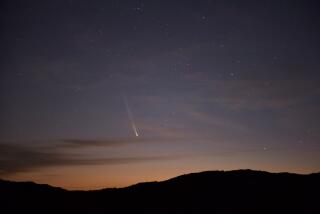Solar Flares Mar Data on Halley’s Comet
- Share via
MOUNTAIN VIEW, Calif. — Solar flares and adverse weather at receiving stations in Spain and in the Mojave Desert punched “holes” in crucial data that the Pioneer spacecraft gathered on the closest approach of Halley’s comet, space agency scientists said Wednesday.
However, National Aeronautics and Space Administration researchers said they are continuing to unravel the mysteries of the comet as it speeds by at 100,000 m.p.h.
The comet, which passes into the Earth’s view every 76 years, has brightened 10% to 15% in the last month while shrinking slightly in size, according to Ian Stewart, lead experimenter from the University of Colorado at NASA’s Ames Research Center. The comet is not visible from Earth now because it is on the far side of the sun.
The gaps in the data over the last few days are serious but probably not fatal to the space agency’s goal of completing an ultraviolet-light-scan photograph of the comet by next week, Stewart said.
Approaching Sun
NASA’s scientists are focusing on measurements of atomic hydrogen from Halley’s as the comet approaches perihelion, or the closest point to the sun, on Feb. 9. At that time the comet will be in its most active period, shedding more ice and dust and racing at 122,000 m.p.h.
Solar flares over the last three days interfered with data collection by decreasing the signal-to-noise ratio from Pioneer, Stewart said. Snow at receiving stations in Madrid and in the Mojave Desert at Goldstone, Calif., also interfered with the signal needed to make an image of the comet over a period of five days.
“The effect of that is to reduce the quality of the data we’re getting and it will ultimately reduce the quality somewhat of the image that we’re able to prepare,” Stewart said. “I don’t know how serious that degradation will be.”






